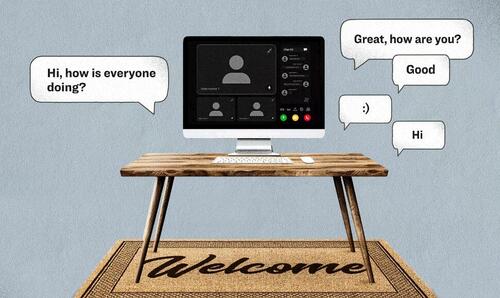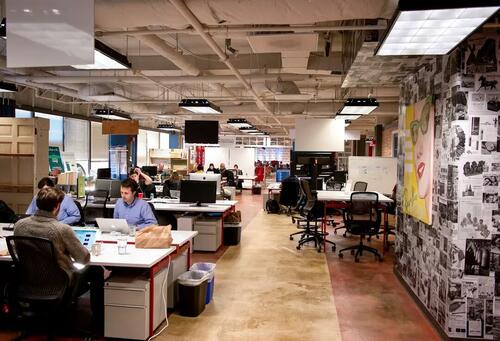Authored by Mark Gilman via The Epoch Times (emphasis ours),
No longer just a by-product of the pandemic, remote work has become a prevalent option for most workforces, with the expectation that nearly a quarter of all workers will be fully remote by 2025, according to a Forbes Advisor report.

However, remote workers are also being laid off at a higher rate than in-house workers, according to data firm Live Data Technologies.
In response, many workers have changed their work habits in an effort to stay relevant.
Leslie Dunbar, a project manager for a national accounting practice based on the West Coast, told The Epoch Times that she has a specific daily ritual to ensure she’s viewed as a vital part of the team, though she’s based in the East Coast.
“I work Pacific time hours by my own choice because that is when my boss and the rest of the team work,” she said.
“No one asked me to do this. I was proactive in thinking through the adjustments I could make for myself that would help my success and the team’s success.”
Terri Kurtzberg, professor of management and global business at Rutgers Business School, said that Ms. Dunbar’s strategy is “spot on,” but also says some burden for effective employee communication needs to be placed on the employer.
“The out-of-sight, out-of-mind problem is very real. But it’s not realistic to say it didn’t work and just come back to the office,” Kurtzberg told The Epoch Times.
“The billion-dollar question is, how do employers manage work without the intangibles that make employees comfortable and how do you know that the work is being done at the levels you expect?”
Another area of concern for remote employees, according to analysis from Live Data Technologies, is that remote workers were promoted 31 percent less often than employees working an in-office or hybrid schedule in 2023.
Live Data Technologies said it looked at a sample size of 2 million white-collar workers split evenly between remote workers and in-office workers.
In 2023, 599,000 people changed jobs within the sample size. Of those, 168,000 individuals left a company and didn’t start a new job within 60 days, which Live Data Technologies classified as involuntary or a “layoff.”

Remote Workers Need to Be More Visible
Dell CEO Michael Dell made that clear in an employee memo released earlier this year that “for remote team members, it is important to understand the trade-offs: Career advancement, including applying to new roles in the company, will require a team member to reclassify as hybrid onsite.”
Rachelle Klozik holds two remote hats as a team supervisor and employee at a Michigan IT company while living in Florida.
She told The Epoch Times that remote employees and supervisors need to engage with co-workers about more than work to remain consistently visible.
“I meet with my team online frequently, and we talk about what’s going on in their lives and how I can work with them better,” she said.
“We have things ... like after-hours Zoom calls and parties and you have to show your face and be involved, showing the company you’re engaged. But there’s more than work to discuss.”
Klozik said the onus to show a human side to remote employee interactions is her responsibility as a supervisor. “I manage people, and if I don’t give them something relatable, people won’t like working for me.”
Not everyone is enamored with remote employees.
Minneapolis Mayor Jacob Frey in a recent speech trying to share why working downtown in Minneapolis was beneficial to companies, called those who choose to work remotely “losers,” according to a video released by Fox 9.
“I don’t know if you saw this study the other day, but what this study clearly showed is that when people who have the ability to come downtown but don’t. When they stay home, sitting on their couch with their nasty cat blanket, fiddling on their laptop. If they do that for a few months, you become a loser. It’s a study. We’re not losers, are we?” he said.
Read more here...
Authored by Mark Gilman via The Epoch Times (emphasis ours),
No longer just a by-product of the pandemic, remote work has become a prevalent option for most workforces, with the expectation that nearly a quarter of all workers will be fully remote by 2025, according to a Forbes Advisor report.

However, remote workers are also being laid off at a higher rate than in-house workers, according to data firm Live Data Technologies.
In response, many workers have changed their work habits in an effort to stay relevant.
Leslie Dunbar, a project manager for a national accounting practice based on the West Coast, told The Epoch Times that she has a specific daily ritual to ensure she’s viewed as a vital part of the team, though she’s based in the East Coast.
“I work Pacific time hours by my own choice because that is when my boss and the rest of the team work,” she said.
“No one asked me to do this. I was proactive in thinking through the adjustments I could make for myself that would help my success and the team’s success.”
Terri Kurtzberg, professor of management and global business at Rutgers Business School, said that Ms. Dunbar’s strategy is “spot on,” but also says some burden for effective employee communication needs to be placed on the employer.
“The out-of-sight, out-of-mind problem is very real. But it’s not realistic to say it didn’t work and just come back to the office,” Kurtzberg told The Epoch Times.
“The billion-dollar question is, how do employers manage work without the intangibles that make employees comfortable and how do you know that the work is being done at the levels you expect?”
Another area of concern for remote employees, according to analysis from Live Data Technologies, is that remote workers were promoted 31 percent less often than employees working an in-office or hybrid schedule in 2023.
Live Data Technologies said it looked at a sample size of 2 million white-collar workers split evenly between remote workers and in-office workers.
In 2023, 599,000 people changed jobs within the sample size. Of those, 168,000 individuals left a company and didn’t start a new job within 60 days, which Live Data Technologies classified as involuntary or a “layoff.”

Remote Workers Need to Be More Visible
Dell CEO Michael Dell made that clear in an employee memo released earlier this year that “for remote team members, it is important to understand the trade-offs: Career advancement, including applying to new roles in the company, will require a team member to reclassify as hybrid onsite.”
Rachelle Klozik holds two remote hats as a team supervisor and employee at a Michigan IT company while living in Florida.
She told The Epoch Times that remote employees and supervisors need to engage with co-workers about more than work to remain consistently visible.
“I meet with my team online frequently, and we talk about what’s going on in their lives and how I can work with them better,” she said.
“We have things ... like after-hours Zoom calls and parties and you have to show your face and be involved, showing the company you’re engaged. But there’s more than work to discuss.”
Klozik said the onus to show a human side to remote employee interactions is her responsibility as a supervisor. “I manage people, and if I don’t give them something relatable, people won’t like working for me.”
Not everyone is enamored with remote employees.
Minneapolis Mayor Jacob Frey in a recent speech trying to share why working downtown in Minneapolis was beneficial to companies, called those who choose to work remotely “losers,” according to a video released by Fox 9.
“I don’t know if you saw this study the other day, but what this study clearly showed is that when people who have the ability to come downtown but don’t. When they stay home, sitting on their couch with their nasty cat blanket, fiddling on their laptop. If they do that for a few months, you become a loser. It’s a study. We’re not losers, are we?” he said.
Read more here...
